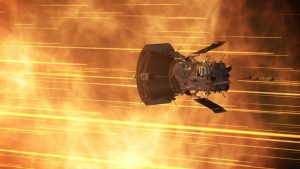
NASA’s Parker Solar Probe executed a short maneuver on Aug. 3, 2023, that kept the spacecraft on track to hit the aim point for the mission’s sixth Venus flyby on Monday, Aug. 21, 2023.
Operating on preprogrammed commands from mission control at the Johns Hopkins Applied Physics Laboratory (APL) in Laurel, Maryland, Parker fired its small thrusters for 4.5 seconds, enough to adjust its trajectory by 77 miles and speed up – by 1.4 seconds – its closest approach to Venus. The precise timing and position are critical to that flyby, the sixth of seven approaches in which Parker uses the planet’s gravity to tighten its orbit around the Sun.
“Parker’s velocity is about 8.7 miles per second, so in terms of changing the spacecraft’s speed and direction, this trajectory correction maneuver may seem insignificant,” said Yanping Guo, mission design and navigation manager at APL. “However, the maneuver is critical to get us the desired gravity assist at Venus, which will significantly change Parker’s speed and distance to the Sun”.
Parker Solar Probe will be moving 394,742 miles per hour when it comes within just 4.5 million miles from the Sun’s surface – breaking its own record for speed and solar distance – on Sept. 27, 2023. Follow the spacecraft’s journey through the inner solar system on the Parker Solar Probe website.
By Michael Buckley
Johns Hopkins Applied Physics Laboratory
